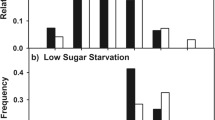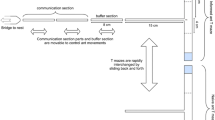Abstract.
In social insects, interactions among individuals are important in colony organisation because they can be used in decision making. During trophallaxis in ants, antennal and foreleg contacts between both partners are established. It has been suggested that a modulatory communication channel could be involved in such contacts, but it remains undemonstrated. The aim of this work was to find variables plausible to be encoded in such contacts and quantify the consequent changes in the tactile stimulation the food-donor ant receives. We recorded nectar transference between pairs of workers in experimental arenas once one of them had returned from collecting sucrose solution (15 or 40%w/w), with different situations of colony’s sugar deprivation. The frequency of antennal strokes that the food-donor ant received on her head depended on both the colony’s sugar-deprivation and the concentration, the latter showed differences within 3–5 deprivation days. Antennal and foreleg movements of the food-receiver increase with increasing level of colony’s carbohydrate deprivation, as well as with increasing concentration of the transferred food. Not only does this study reopen an interesting question, but it gives evidence that variables related to the appetitive context are indeed encoded in the tactile stimulation during the trophallaxis as well. Consequently, they have the effective potentiality to play a communicational role in the organization of colony activities.
Similar content being viewed by others
Author information
Authors and Affiliations
Corresponding author
Additional information
Received 22 December 2005; revised 5 April 2006; accepted 12 April 2006.
Rights and permissions
About this article
Cite this article
Mc Cabe, S., Farina, W.M. & Josens, R.B. Antennation of nectar-receivers encodes colony needs and food-source profitability in the ant Camponotus mus. Insect. Soc. 53, 356–361 (2006). https://doi.org/10.1007/s00040-006-0881-x
Published:
Issue Date:
DOI: https://doi.org/10.1007/s00040-006-0881-x




